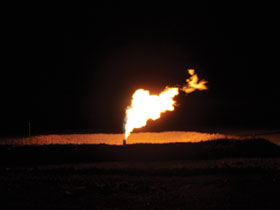

Flare gas and vent gas systems are used around the world in various industries including oil and gas production, refining, chemical processing, gas plants, wastewater treatment facilities and landfills. The systems are utilised to burn off waste gases, dispose of surplus gases and protect people, equipment and the environment. The measurement and monitoring of flare gas is necessary to assure that the flare system is operating correctly. Additionally, strict environmental regulations often require the measurement of flare gas emitted to the atmosphere. Unfortunately, there are inherent challenges to measure and monitor flare gas that need to be overcome. These include: extreme flow variation, potential for changing gas composition and working in hazardous locations. Thermal mass flowmeters offer solutions for flare gas measurement and monitoring in many of these applications.
What is flare gas?
Flare gas systems are commonly used in industrial plants all over the world. Flare gas is the surplus gas or vapour which is typically burned through a gas flare, also known as a flare stack. Gas flaring or venting is the process of burning off combustible gas (flare gas). A gas flare is a gas combustion device used to burn off excess hydrocarbons that cannot be processed. This is a safety measure as if the gases were not burned and released into the atmosphere they could create a combustible environment.
The purpose of gas flaring has historically been to dispose of excess combustible gases or relieve the gas pressure within a system. When global warming wasn’t considered an issue, gas flaring became a widely accepted process. Back then there were no significant concerns relating to the environmental impact of emissions and no incentives were given to maximise or recycle the gas destroyed in the flaring process.
Today there is a shift from burning flare gas to reducing the amount of flare gas released into the atmosphere. Natural gas is a valuable resource and efforts to capture and recycle flare gas into renewable energy takes precedence over destroying it. Additionally, increasing pressure from federal and state legislation encourages the reduction of emissions and flare reduction is being deemed as significant to achieve this. By recycling the waste gas, the carbon footprint is reduced and the site is provided with an alternate source of energy.
Today, gas flares are subject to stringent regulations, frequently requiring operators to measure, record and report the amount of flared gases. Aside from the measurement of the gases, it is often necessary to monitor flare gas flow at various points within a complex run of pipes including the actual flare stack. Flow monitoring provides the user with an understanding of the gas source flowing to the flare, as well as a relative flow rate.
Web exclusive: to find out more about the measurement challenges posed by these applications and the solutions available using Sage thermal mass flowmeters, visit http://instrumentation.co.za/+C18675
| Tel: | +27 82 468 5403 |
| Email: | [email protected] , [email protected] |
| www: | www.envirosa.com |
| Articles: | More information and articles about Environmental Process Analytics |

© Technews Publishing (Pty) Ltd | All Rights Reserved